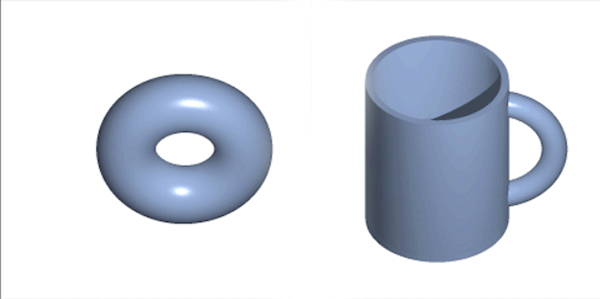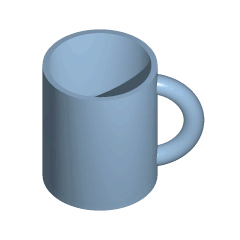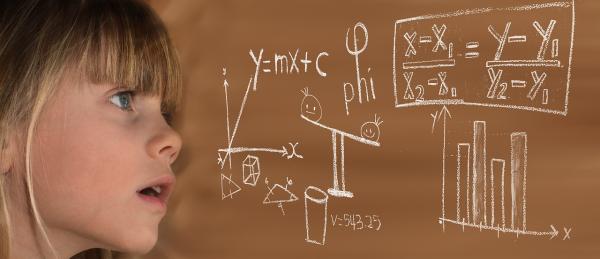“Fräulein Noether was the most significant creative mathematical genius thus far produced since the higher education of women began. In the realm of algebra, in which the most gifted mathematicians have been busy for centuries, she discovered methods which have proved of enormous importance in the development of the present-day younger generation of mathematicians.”
- Albert Einstein, letter to the NY Times, 1935
Einstein wasn’t the only eminent scientist to describe Noether as the greatest woman mathematician who ever lived - just the most well-known. This isn’t surprising, considering she provided the mathematical underpinnings  validating his General Theory of Relativity. Another Nobel Laureate, Leon Lederman, compared Dr. Noether’s work to that of Pythagoras.
validating his General Theory of Relativity. Another Nobel Laureate, Leon Lederman, compared Dr. Noether’s work to that of Pythagoras.
What’s Algebra – Besides a Distant Memory from Junior High?
Regular algebra is defined as
“the branch of mathematics in which abstract symbols [or unknowns], rather than precise numbers, are manipulated or operated with arithmetic.”
Algebra seeks to generalize symbols beyond discreet combinations of numbers – the province of standard arithmetic. It does this by isolating or equalizing unknown factors to ones we know. Using standard arithmetic (addition, subtraction, multiplication, or division), one set of ideas or constructs is manipulated to equalize another.
Here’s an example: Let’s say you want to buy a used car selling for $21,000. You have $6,000 in the bank ready for a down payment but must accumulate the rest in a year. You are paid three times a year. What you don’t know (the unknown) is how much you need to save each pay period. In algebraic terms, the equation is $21,000 = $6000 + 3x.
X simply represents the unknown amount you need to save each pay period. We manipulate these numbers and symbols, isolating x on one side of the equation to identify what x equals. That’s regular algebra, and the answer is $5,000.
What’s abstract algebra?
Here’s how generative AI defines it:
“Rather than focusing on specific numerical computations or equations, abstract algebra examines the properties and relationships that hold true across different mathematical systems or groups of numbers and concepts. It seeks to understand the fundamental concepts and structures that underlie various mathematical objects and operations.”
Abstract algebra, where Emmy Noether made groundbreaking contributions, extends algebraic reasoning beyond individual equations to groups of ideas or equations.
But First She Was a Little Girl:
Born in Germany in 1882, Emmy was first taught “feminine” subjects like cooking, cleaning, and piano,- which she didn’t like. She was near-sighted, spoke with a lisp, didn’t give a whit how she looked, and didn’t stand out academically. But she loved to dance and mathematics. Sadly, higher education for girls in Germany at the time wasn’t acceptable; the Academic Senate of the University of Erlangen, where her father was an eminent mathematics professor, declared that mixed-sex education would "overthrow all academic order." However, with the professor’s permission, she was allowed to audit classes. Eventually, that repressive attitude receded, and Emmy became Dr. Noether in 1907, receiving her doctoral degree with the highest honors.
She began lecturing – unpaid -- in 1908 as a substitute for her father, as the idea of a woman in higher education was still considered repugnant. In 1915, she was recruited by David Hilbert, the mathematician Einstein consulted to furnish mathematical support for his work (and who famously said, “Physics is too hard for physicists”), to teach at the University of Gottingen as a privatdozent (an unsalaried lecturer), but the philosophy and history departments protested: "What will our soldiers think when they return to the university and find that they are required to learn at the feet of a woman?" To this, Hilbert responded, "I do not see that the sex of the candidate is an argument against her admission as privatdozent. After all, we are a university, not a bathhouse." Hilbert’s retort changed nothing.
Four years later, Emmy did become a privatdozentin, delivering her first lectures under her own name – but only after she crafted Noether’s Theorem in 1915, reconciling the dilemmas in Einstein’s Relativity Theory, publishing it in 1918.
Noether’s Theorem: The Search for Symmetry
Until Emmy resolved the impasse, Einstein’s General Relativity theory seemed to break the laws of the conservation of energy. (This states that energy cannot be created or destroyed, although it can be changed from one form to another). The difficulty related to universal symmetry, invariance, i.e., how/why different things can be depicted or expressed as the same, Emmy’s specialty. Here’s how it works:
 In a perfect universe, things are perfectly symmetrical, like the sphere. No matter from what perspective you view it, it appears the same. Physicists need equations whose symmetry is as sphere-like as possible. Equations can’t change depending on where you are (space invariance), nor at what time you use them. (Time invariance). Now, look at the cylinder. While still having symmetry, they’re not as symmetrical as a sphere. So, they need different equations.
In a perfect universe, things are perfectly symmetrical, like the sphere. No matter from what perspective you view it, it appears the same. Physicists need equations whose symmetry is as sphere-like as possible. Equations can’t change depending on where you are (space invariance), nor at what time you use them. (Time invariance). Now, look at the cylinder. While still having symmetry, they’re not as symmetrical as a sphere. So, they need different equations.
“Noether discovered that for every invariant … in the universe there is a different conservation law. Equally, for every conservation law in physics, there is a different invariant…. Noether’s Theorem shows that the law of conservation of energy is ... a consequence of time invariance in classical physics. …Alternatively … time invariance [symmetry] is caused by the law of conservation of energy.”
Noether’s Theorem allows physicists to propose abstract symmetries, knowing there must be a conservation law attached to each of them, which they then determine inductively, [1] allowing Einstein to plug the mathematical holes in his theory. Leon Lederman, the Nobel-winning discoverer of the 6th quark, called Noether’s Theorem "one of the most important mathematical theorems ever proved in guiding the development of modern physics.”
In 1922, a year after Einstein won the Nobel prize, Noether became an untenured professor –continuing to teach without pay. Only in 1923 was she awarded the rank of a salaried “ordinary” professor. This was
- 87 years after Caroline Herschel was inducted into the Royal Academy of Sciences in England
- 53 years after Ellen Swallow Richards earned a degree in chemistry in the US and began developing the field of toxicology.
- 20 years after Marie Curie shared the Nobel Prize in Physics with her husband and 12 years after she won her second Nobel – (in Chemistry) - alone.
Dr. Noether wasn’t to stay long as a paid Professor at the University of Gottingen. Even as she battled sexism in German academia, Hitler was jettisoning Jewish academics. She left Germany in 1933 to teach at Bryn Mawr, one of the Ivy “Seven Sister” schools for women, where she continued to teach, develop new ideas, and mentor doctoral students until her untimely death at age 53 in 1935.
Topology: The Search for Connectedness
Among her other contributions is her algebraic analysis of topology. Here, mathematicians study the characteristics of objects that remain unchanged even when deformed or transformed, focusing on the object’s connectedness.
"A topologist cannot distinguish a donut from a coffee mug" since they can be continuously deformed into one another.”
No matter how we deform it—whether we stretch, compress, or twist it—it remains one single connected piece. This connectedness, homeomorphism, means two objects can be transformed into the other by continuous deformation without tearing or gluing.
The Law of Shapeshifting :
Can you see the connectedness between the donut (torus) shape and the coffee mug? Scroll down for the answer.

Tap on the object below, and it will transform from cup to donut. (Dr. Noether described this mathematically; I will refrain.)

A continuous deformation of a coffee cup into a doughnut and back. [2]
Finding symmetry and connectedness in nature is a gift. In the abstract, perhaps it’s something we should try to cultivate.
[1] Inductive reasoning involves starting from specific premises and forming a general conclusion.
[2] Demonstration of topology of donut and cup by Lucas Vieira, in the Public Domain, on Wikipedia
Additional Reading:
Here is a more extensive biography of Dr. Noether by the School of Mathematics and Statistics University of St Andrews, Scotland




